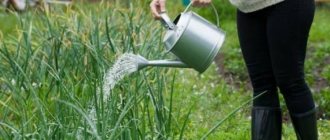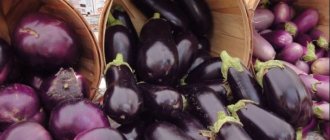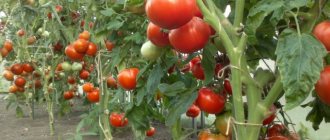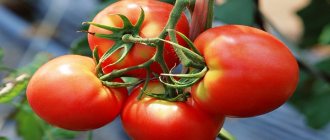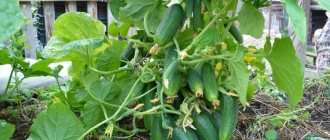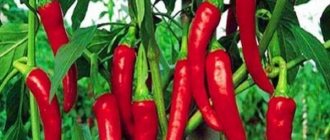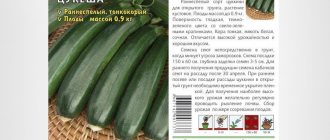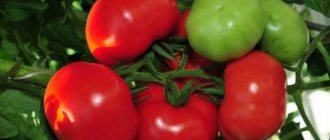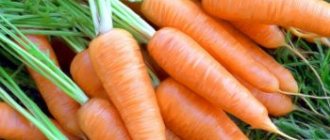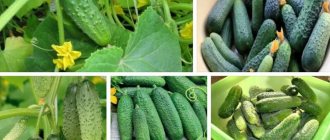Radar
The Radar onion set is a Dutch hybrid. The bulb has dark green leaves, the head is large and round, slightly flattened. It can reach a weight of 300 grams, and with proper care, more. The husk is quite strong, due to which the crop is stored longer compared to other varieties of the crop. In addition, the plant can survive frosts - up to -15 degrees in the absence of snow or -23 in the presence of snow. Another advantage highlighted by summer residents is resistance to the formation of shoots and excellent immunity (but at the same time it must be protected from fungi). Radar does not require close care; it is also not afraid of parasites. This is a winter variety of onion sets; you can get the harvest as early as May.
Video about what planting material is worth buying and what not to buy
In this video, the author of the video shares his experience in choosing onion sets. She talks in detail about different successful types, and also gives examples of reviews from her friends and relatives.
Although we have already examined many of the varieties, the importance of the video is that it shows what planting material you do not need to buy. You should especially distinguish between those that are infected with thrips (a small pest that attacks root crops). If you don’t know this and buy a defective one, then it can later infect healthy people.
It is also important to know at what storage temperature and under what conditions it should be stored until planting time. This is very important information for successful germination and an excellent harvest.
Follow the advice of experienced gardeners and you will always have excellent harvests.
Sturon
Onion sets Sturon produce a harvest 15 days earlier than other varieties. The weight of the bulb ranges from 90 to 150 grams. It is important to remember that this crop cannot be used for greens; the taste of the feathers leaves much to be desired. The hybrid loves warm climate zones, so it is best to grow it in the South. The popularity of the variety is due to the taste of the bulbs and pronounced aroma, due to which they can be used for various purposes - from fresh consumption to preservation. The productivity of Sturon is high, up to 30 tons per hectare.
The shelf life of collected bulbs is long; you can leave them for six months and they will not spoil.
The plant has high immunity to most diseases relevant to onions. It is not afraid of fungi and unfavorable environmental conditions, due to which there is no need to treat it with chemicals before growing. The culture is resistant to frost and bolting. Prefers sandy and loamy soils.
Timiryazevsky
Onions with a sharp or semi-sharp taste were created on the basis of the Rostov onion. The onion ripens early. It has high productivity. Its head is round and flattened, covered with golden scales. The pulp is dense, white. Here are the main qualities of the Timiryazevsky onion set variety:
- The growing season lasts 85-95 days.
- There are 2-3 rudiments in the nest.
- Head weight - 50-70 g.
- About 100% of turnips ripen if the weather is suitable.
- Onions last a long time; about 95% of the heads are preserved until spring.
- The taste is spicy.
This variety is most often grown in Siberia, the Volga region, and the Urals. It produces a thick, juicy green feather and medium-sized bulbs. Only sets are suitable for breeding. From the seeds you can only get small bulbs for planting next year. It is best to grow seeds in greenhouses.
Centurion
A recent development of agronomists is the Centurion onion set. The fruits of the plant have an interesting oblong shape and can weigh up to 200 grams. Their taste is quite sharp and pungent, so these onions are not suitable for fresh consumption. It is best used to prepare salads or complement meat.
Centurion grows at temperatures from 12 to 16 degrees; in open ground it can survive temperature drops of up to 2 degrees. To improve growth, it is recommended to water the plant during the growing season.
To obtain a high-quality harvest, you need to choose good planting material: it should not be wet, the best bulbs are those that look strong and healthy. It is recommended to carry out planting activities towards the end of September or in the first half of October in sandy loam soil, before the onset of frost. This will allow the young plants to harden and gain moisture. Active growth of the crop begins immediately after warm weather sets in. In April, the collection of the green part begins.
Large varieties
Among the varieties of onions, we can separately distinguish those that bear fruit with especially large heads. Their popular representatives include the aforementioned Exhibition, as well as some other cultures.
Globo
A salad variety with a late ripening period, which is recommended to be cultivated through seedlings, sowing the seeds in early March. If you provide the plant with additional lighting and fertilizing with mineral fertilizers, after 120-130 days you can get a harvest of heads with the following characteristics:
- shaped like a wide ellipse;
- on average they weigh 700-800 g, although there are huge specimens weighing up to 1 kg;
- have a yellowish-orange husk and internal white scales;
- The taste is sweet and very juicy, but without a sharp onion smell.
Harvest from 1 sq. m of bed - about 9-12 kg. The bulbs should be consumed immediately and not stored for long-term storage, as they tend to sprout.
Russian size
If you grow the crop through seedlings, sowing seeds in February, then already in August-September you can get huge bulbs with a record weight of 3 kg. They have a round shape with a slightly elongated neck and are covered with golden-yellow scales with a greenish tint. The flesh itself is creamy white and has a gentle piquant pungency. It does not have a strong characteristic odor.
Bulbs weighing 3 kg each have a low shelf life, so they should be immediately consumed in salads or preparations.
White Wing
A hybrid of onions characterized by powerful roots and leaves. After 90-100 days from the moment of planting, the plant bears fruit with round snow-white bulbs of impressive size - an average of 400 g. The pulp is also white and has increased juiciness.
This hybrid can be grown in any climate zone. It does not require special care, can withstand heat and drought, and is not susceptible to fungal diseases. The bulbs can be stored for 5 months. They are suitable for both fresh consumption and canning.
To grow onions in your garden, first of all, you need to decide on its variety. The most popular representatives of this culture can be found above. Thanks to the wide variety of varieties and hybrids, every gardener will be able to choose the appropriate option.
0
0
Copy link
Hercules
The Hercules onion set is a mid-early variety. It has fairly large fruits, the weight of which is usually around 150 grams. Onions have a pungent taste, so they are often used for cooking various dishes or canning.
Among the main advantages of the variety is high yield. Even from a square meter it is possible to get up to 8 kilograms of onions. At the same time, the shelf life of the fruits is long; they last up to 10 months, remaining of high quality.
It is worth noting that Hercules has good immunity to most diseases and parasites. It doesn't produce a lot of feathers; all the growth goes into the bulb. In addition, the plant has a very powerful root system, due to which it can draw water from great depths. Drought resistance is high.
Before planting, it is worth warming the bulbs near the radiator for 4 days. Experts note that they can be planted only when the air temperature constantly remains at +10 degrees. Otherwise, the seed may be damaged. The best place is an open area with insolation. When grown in lowlands, the crop will have less shelf life. Further care consists of systematic weeding and watering.
Onion sets: processing before planting (video)
When growing onions, it should be taken into account that when the greenery grows slowly, it is very important to fertilize with a solution consisting of one glass of bird droppings or mullein, diluted in a bucket of water, with the addition of a tablespoon of urea. The standard consumption of nutrient solution is about three liters per square meter. The next application of fertilizers is carried out after two weeks. It is necessary to weed, loosen and water the beds with onions, which will allow you to obtain high-quality and large bulbs.
Cupido
Another Dutch variety of onion sets. It is considered an early and high-yielding hybrid. Cupido is especially popular among farmers involved in the industrial cultivation of this crop - its yield is impressive (up to 9 kilograms per 1 m2). The shape of the fruit is slightly elongated, the husk is dense but thin. Weight is about 150 grams, the taste is quite soft and pleasant. The culture easily adapts to almost any environmental conditions, with the exception of low ambient temperatures.
This variety is not suitable for open ground. Cupido onion sets feel best under agrofibre or in greenhouses. Before planting, you should carefully prepare the material. The soil must be cleaned, free of weeds; it is recommended to dig it up and fertilize it with organic matter. Planting can be done in spring or in the first ten days of November. In the latter case, the fruit will gain enough moisture and acquire a sweetish taste.
Onion
The plant is a perennial. Grown exclusively for feathers. The leaves are quite large, diameter up to 15 mm, length about 35 cm. The plant is not suitable for storage, since the formation of pseudo-bulbs may occur. Batun onion is characterized by high productivity in the first 2-4 years, after which a decrease in growth intensity is observed.
Common varieties include:
- "April";
- "Valdai";
- "Tokyo";
- "Tenderness".
"April"
This variety is frost-resistant. Contains vitamins A, B, C in abundant quantities. The variety is poorly cultivated in acidic soils. The period of growth of the first leaves is early spring.
Valdai
The advantages of this variety are as follows:
- increased productivity;
- resistance to frost and low temperatures;
- not susceptible to bolting;
- the plant is classified as medium-sized;
- dark green foliage;
- leaf height – up to 50 cm;
- yield – up to 2.5 kg per 1 m2.
"Tokyo"
The variety is an early ripening variety, widespread throughout almost the entire territory of Russia. The leaves are fist-shaped, the direction of growth is vertical. The leaves have a barely noticeable waxy coating. Their height usually does not exceed 40 cm.
The leaves taste very juicy, tender with a slight hint of pungency. The variety tolerates frosts, frosts, and lack of snow cover very well. Productivity – up to 4 kg per 1 m2. For feather cultivation, planting is carried out in the second part of April.
"Tenderness"
The differences between this variety are as follows:
- early ripeness;
- frost resistance;
- very tender and tasty leaves;
- high yield (4.5-5 kg per 1 m2).
Thus, the cultivation of various onion varieties must be carried out in strict accordance with the requirements and recommendations. When deciding to grow a particular variety, it is important to take into account compatibility with the climate and soil, take into account tips on preliminary soil preparation and caring for the planted plant. Onions are harvested from the garden bed for storage in accordance with the optimal duration of cultivation of onions of each variety.
It is also necessary to take into account the principle of annual or perennial cultivation and soil recommendations for various types of cultivation.
So we looked at the most popular onion varieties . If you liked the article, be sure to share it on social networks using the appropriate button below. I also look forward to your comments.
Red Baron
The red variety of onion sets is distinguished by early ripening of fruits and amazing taste. It requires little maintenance and is immune to many common diseases. The shape of the bulb is a flat oval, the color is burgundy and purple. The scales are dense and quite strong. The average weight of the fetus often reaches 200 grams; with proper care, this figure can be higher. From 1 m2 it is quite possible to get up to 3 kilograms of harvest. Keeping quality is good if stored correctly.
To obtain high-quality bulbs, it is important to water the Red Baron correctly and in a timely manner, loosen the soil and feed the plant (twice a month). In general, the plant is unpretentious in care. Harvest by carefully digging in mid-August (after the feathers begin to turn yellow). Store it in dry, cool cellars.
Shallot
Shallots are one of the tastiest and oldest of all. Cultivated since 1261, today it is distributed almost throughout the world, which is primarily due to its excellent organoleptic properties.
The bulbs themselves are small, but they store very well and for a long time. Shallots are early ripening. Among the common productive and resistant varieties with the best organoleptic properties, it is worth highlighting the following:
- "Kuban yellow";
- "Belozerets";
- "Kunak".
"Kuban yellow"
The variety was bred by employees of the Krasnodar Research Institute in the middle of the 20th century. It is considered universal, that is, suitable for cultivation in any area without additional specific soil requirements. At the same time, this onion variety tolerates drought well, which largely determines its popularity and prevalence in arid areas.
The shape of the bulb can be round or round-flat, weighing from 75 to 130-135 grams. The pulp itself is very juicy and contains semi-sharp flavors. Scale colors: yellow and brown-yellow.
“Kuban Yellow” is a mid-season variety. As for fertility, an average of 3-4 kg of onions are harvested per 1 m2.
"Belozerets"
This variety was also bred by employees of the Krasnodar Research Institute. It has a number of significant differences from its “brother”:
- precocity;
- oval and round-oval bulbs weighing 20-27 grams;
- small variety;
- pungency of taste;
- the color of the scales is light lilac.
Onion varieties intended for cultivation
Despite the widespread use of onions in cooking, turnips also have excellent taste and nutritional properties. To obtain greens, they turn to growing excellent varieties of onions.
"Centipede"
The Magpie onion has a slightly pungent taste, one might say sweet. Therefore, it is very good to use it in salads. The bulbs appear elongated and have golden scales. It is grown both during spring and autumn planting before winter. Reproduces by division. From one planted bulb, at least 6 new ones are formed.
Shakespeare
Shakespeare onion sets are one of the most popular winter varieties. The fruits are round in shape and white in color. The taste is spicy, but not too strong. The scales are not red, but dark brown and dense. Their weight is about 100 grams, the pulp is juicy and white, and has a bright smell. The variety practically does not form arrows.
Shakespeare is an early ripening variety. With proper care, you can get a harvest within a month and a half after the first shoots appear (approximate amount per square meter is 3.5 kilograms). Due to the dense shell, the culture feels great even in cold weather down to -18 degrees.
Shakespeare is immune to most diseases associated with onions. Due to this, you can use less chemicals, and the harvest will be more environmentally friendly. It is worth remembering that the plant is often attacked by insects; the onion fly is especially dangerous.
For sowing, bulbs with a diameter of no more than a centimeter are selected. Experts say that this will allow you to get a quick harvest. By the way, there is no need to soak the planting material, nor do you need to trim the necks of the bulbs. It is best to sow in the fall, so that the fruits turn out larger due to saturation with moisture. In addition, you can use even very small bulbs that may not survive until spring.
For a high-quality harvest, you must properly care for the crop. It must be watered, fertilized and treated against diseases and parasites. Onion harvesting begins one and a half months after germination.
Late ripening
The growing season for these varieties is more than 120 days. They have a good shelf life, excellent taste, and are intended for universal use.
Bamberger
New, it is recommended to grow both for feathers and turnips. The inner scales are milky white, very fleshy, the upper ones are yellow and dry. Small bulbs have an elongated shape
The mild taste of the bulbs with barely noticeable burning notes makes the variety suitable for use in salads.
By ripening time:
- Forcing to feather - mid-early
- Bulb ripening – late
- Juicy, crispy flesh
- Long shelf life
- Resistance to shooting
- Not susceptible to fungal diseases
Globo
- Belongs to a late-ripening variety. It takes 4 months from sowing seeds to harvesting.
- A budget option, it is valued for the opportunity to grow bulbs from seeds without spending money on buying sets.
- Recommended for growing through seedlings. Sowing of achenes is carried out in early March.
- Young plants require additional lighting and fertilizing with organic fertilizers (once every 2 weeks).
- Loan seedlings are planted in the garden bed. Care is the same as for all varieties of onions: watering, loosening the soil, applying fertilizers.
- Suitable for growing in various regions of Russia
- Characterized by disease resistance
- Has a long shelf life
- High yielding
- The bulbs resemble a wide ellipse, are painted yellow, very large
- The pulp is juicy, there is no pungent onion smell
Red Baron
- The bulbs are colored red.
- It is resistant to the climatic conditions of different regions, so its cultivation is possible everywhere.
- The red, juicy pulp of the Red Baron variety adds zest to vitamin salads
- The rounded bulbs have a uniform structure and high density, the scales are red or purple.
- The crispy pulp is pleasant to the taste, without bitterness. Resistant to blight, fusarium and root rot.
- The color of the pulp contrasts with other vegetables, making it ideal as an ingredient in vitamin salads.
- When growing, it requires moderate watering, especially in dry weather. But excessive watering can lead to cracking of the bulbs, resulting in short storage.
- High yield
- Ripening period – 125 days
- Stable yield
- Good keeping quality
Exhibition
- Obtained by Dutch breeders.
- The long growing period (80 days) requires the seedling method. In some regions
- In Russia, this is the only way to get a high harvest.
- Sowing for seedlings - the last ten days of February - the first days of March.
- Sowing is carried out in sandy loam soil, humus, complex fertilizers and wood ash are added.
- After planting the seedlings in the ground, water them abundantly.
- In the first half of summer they are fed with nitrogen fertilizers.
- Towards the end of the growing season, watering and fertilizing are stopped, and the greenery is allowed to lie down and the scales turn yellow.
- The bulbs are dug up with a pitchfork, removed from the ground, cleaned, dried and stored.
Bamberger
A variety of German selection with a weak pungent taste. The shape of the fruit is elongated, the scales are bright yellow. The onion is small in weight, maximum 80-100 grams. Using it you can prepare delicious and savory dishes, especially salads. The shelf life of the crop is 5 months.
Before planting, you should carefully prepare the material - dry it to prevent damage. For a couple of weeks it is kept in a room with a temperature of +20 degrees, and on the eve of planting it is raised to +35-40 degrees. This will facilitate germination and reduce the number of shoots. The culture prefers sandy loamy fertile soil. You can plant before winter or spring. In the first case, sowing is carried out a couple of weeks before the onset of cold weather, in the second - at the end of April or beginning of May.
Care includes a number of simple measures: watering, loosening the soil, feeding three times a day and treating against parasites. Summer residents speak positively about Bamberger onion sets and say that they are satisfied with the harvest.
Chalcedony
This variety of white onion set has an average ripening period. Chalcedony has a high yield. The bulbs are round or oval, large. The scales are yellow-brown or golden, the flesh is white, juicy. It stores well in winter, less than 1% of the heads rot.
Here is a description of the quality of the variety:
- The growing season lasts 95-115 days.
- Productivity is up to 4 kg per meter of bed.
- There are 1-3 bulbs in a nest.
- The mass of a turnip is 85-100 g, giants reach a weight of 300-400 g.
- The taste is spicy or semi-sharp.
Most often, Chalcedony is grown in the southern regions for feathers and turnips, but you can get greens and heads in the northern regions. The vegetable is propagated by sets and seeds. It is highly resistant to peronosporosis and slightly less resistant to neck rot.
Corrado
The Corrado onion set is one of the latest achievements of Dutch breeders. The variety is considered universal: green leaves and juicy bulbs are common in cooking and are most often eaten fresh. Corrado can be grown almost anywhere due to its ability to adapt to different environmental conditions. The average yield is 33 tons per hectare, but this figure can be significantly improved with proper care.
The bulbs are distinguished by their good presentation and large size. Their shape is round and even. The weight of one fruit is up to 100 grams. The taste is pleasant and bright, not too spicy, without bitterness. Can be used for freezing and drying.
Sets do not require treatment before planting; they have excellent germination rates. Planting is done either late in the fall or in the spring. In the latter case, events are held towards the end of April or at the beginning of May. During the day it should be at least +10 degrees Celsius, and constantly. First, small material is placed in the ground, and then larger material. You should expect germination in a week and a half.
A better harvest can be obtained by planting in October or November after the first frost hits the soil. You can even be a little late with the deadlines to prevent the growth of the seedlings.
Care is not difficult, all manipulations are quite standard. It is necessary to water the plant, especially in dry weather, weed it and, if necessary, thin out.
Red Baron
Red Baron is a variety of early purple onion. It is not demanding in care and adapts well to different weather conditions. The weight of the ripe fruit depends on the density of planting the seed in the ground. The shape is round or slightly flattened. The top layer (husk) is quite dense. It is characterized by fleshy, juicy pink-white flesh with red-violet streaks.
With timely thinning of the planting, the bulbs can gain weight up to 100 g. Red Baron Sevok easily tolerates winter frosts. After suffering severe frosts, flowering arrows may not form. This is an excellent onion variety for winter planting, ripening in June.
Important! In areas with risky farming, the time for planting turnips in the ground should not be delayed. At the beginning of May, Baron should grow in the garden.
Centurion
Onion Centurion is an early ripening common crop. It is grown in both southern and northern latitudes. The bulb has a neat elongated shape with a dense consistency. One head weighs on average 100 g. The husk is bright straw color. The inner flesh is white. The scales are tightly closed with each other; there are about four layers of them in each bulb. Due to the fact that the neck is narrow, it dries out quickly, preventing pests and microbes from entering the body of the bulb. The size of the set is small - about 2 cm in diameter. Centurion's productivity is at a high level.
Stuttgarter Riesen
Stuttgarter Riesen onion is a variety of large onion with a round or flattened shape. The maximum weight of the fruit reaches 250 g. On average, one bulb has 100–150 g. The color of the outer layer can be white or light brown. The taste is semi-sharp. Valued for its high content of vitamin C. Stuttgarter Riesen onions have a high dry matter content, which allows the onion to be dried and frozen without losing its beneficial properties. Stored quite well. The ripening period from the appearance of the first shoots is on average 90 days.
Ellan
Ellan is a variety of ultra-early winter onions. The diameter of a mature bulb is 6–8 cm, weight is about 120 g. Sometimes you can find fruits weighing 0.5 kg with a diameter of about 15 mm. The onion has a round and rounded-flat shape. The interior is protected by dry cover sheets consisting of 1–3 layers. The leaves are yellow or straw colored. The pulp is juicy, white, up to 8 mm thick. The structure is loose. The taste is sweet. In a favorable environment, the yield is high, sometimes exceeding the average of other varieties by 30%. Winter plantings do not require maintenance, which affects the low cost of the product.
Rumba
A variety of Dutch selection, suitable for cultivation in northern or middle latitudes. The bulbs are moderate in size and round in shape. The approximate weight of the fruit is 110 degrees, although some specimens reach a weight of 600 grams. The scales are dense and strong. The taste of onions is pungent with bittersweet notes. Rumba has a universal purpose - it can be used both fresh and for canning.
This onion set is suitable for the Urals or Siberia; the most important thing is to choose slightly acidic sandy loam or loamy soil for it.
The variety is mid-season, but can also be late-ripening. The rate of ripening depends on specific environmental conditions. With properly organized care, the harvest can be harvested after a couple of months, but sometimes you will have to wait longer.
It is advisable to plant seedlings before winter, choosing healthy material with a diameter of 1 centimeter; it must be kept in a manganese solution. Before planting, the soil is thoroughly loosened and leveled.
The productivity of Rumba is high; from 1 hectare you can get up to 50 tons of fruit. The degree of crop safety remains at 98%. The keeping quality of the bulbs is good, they remain in good condition for up to 9 months.
Separately, it is worth highlighting the variety’s resistance to diseases and pests. The only ailments that are most dangerous for it are powdery mildew, neck rot, mosaic and nematode. For prevention, it is enough to treat the planting material well and organize proper care.
Medium ripening
The growing season for these varieties ranges from 100 to 120 days. They are grown in different regions, mainly through planting sets. Varieties with an average ripening period are well stored, the bulbs can be transported over long distances, the heads are used for canning, eaten fresh and pickled.
Bessonovsky
Currently, breeders are working to improve the characteristics of the variety, trying to return it to its former popularity.
- Small round or flattened bulbs, weighing up to 40 g
- Tightly fitting scales
- Spicy taste
- Long shelf life – up to 8 months
- Good presentation
- Average yield
- Not very resistant to diseases, susceptible to bottom rot and downy mildew.
- For preventive purposes, it is recommended to spray plantings with agents against pathogens of various diseases.
- A budget variety with good characteristics: good keeping quality, average yield and sharp taste of the pulp.
Hercules
- Characterized by a long shelf life. During this time it does not lose its taste. It has a mild taste and onion aroma.
- Planting of seedlings is carried out after the ground has warmed up to +10 °C.
- Prefers fertile soil.
- It is recommended to add humus, peat, urea and superphosphate (1 tablespoon each) to the loams.
- If the soil is sandy, add peat, humus, 2 buckets of clay soil, superphosphate and urea (1 tbsp each).
- Productivity per 1 m2 – 8 kg
- Long shelf life without loss of taste
- Disease resistance
- A well-developed root system allows you to “survive” in dry times
- Spicy but pleasant taste.
Sturon
- Dutch selection of medium ripening period. Around day 105, the bulbs reach technical ripeness. Suitable for growing in areas with both warm climates and temperate climates.
- Onion sets can be cultivated using annual and biennial cultivation methods. In the second year you can get large bulbs weighing up to 200 g.
- The bulbs are distinguished by their increased shelf life: they are stored all winter and do not lose their taste for 9 months. This feature increases the cost of the bulbs if its cultivation is used for commercial purposes.
- Depending on the fertility of the soil, up to 29 tons of crop can be obtained from 1 hectare. Grows well in sandy loam soils. Feedback from farmers indicates that onions are rarely affected by any insects, and therefore do not require frequent treatment with chemicals.
- They are grown not only in open ground, but also in greenhouse conditions to produce greens.
- During the growing season it is necessary to apply mineral and organic fertilizers. Once the bulbs reach a size of 2.5 cm, all feeding should be stopped. In the second year of cultivation, it is necessary to feed the plantings 2 times. Onions grow best on loamy and sandy soils.
Chalcedony
- Belongs to breeders from Moldova. The white, juicy flesh of the oval or round bulbs has a pungent taste, but not acrid. The weight of one onion is up to 90 g.
- The variety is valued due to its high yield: from 1 m2 - up to 5 kg of onions. The harvest is harvested in August. The scales are bronze with a brown tint. Feature of the variety: during growth, the bulbs are located above the soil surface, which accelerates their ripening and facilitates harvesting.
- The bulbs of the variety are impressive in size, but the yield depends on climatic conditions and soil fertility.
- Chalcedony is rich in vitamins, contains folic acid, essential oils, and carotene.
Carmen
Red onion, which is very popular among summer residents. They brought him out in Holland. The density of the fruits is moderate, they are round-flat in shape and weigh no more than 70 grams. Carmen onion sets quickly adapt to environmental conditions and respond adequately to temperature changes, droughts and rains. So you can grow it in the northern regions.
Sets suitable for planting must be dense and whole, and free from any damage or suspicious odors. It is very important to inspect them for rot. You should not plant specimens with a diameter of more than 1.5 centimeters - they are prone to bolting.
Carmen is not a very demanding variety, for a good harvest you need to water it often (the specific schedule depends on weather conditions, usually activities are carried out 1-2 times every 2 weeks), fertilize (three times during the entire growing season) and monitor environmental conditions, to respond to them in a timely manner.
During the growing season, feathers can be trimmed and added to various dishes. If they are not needed, they are removed before harvesting.
The variety is afraid of such parasites as onion muskellunge, onion fly and moth, nematode, and root mite. It is very important to treat onions to prevent them from appearing. In addition, you need to protect the plant from fungi.
The yield with proper care is not bad - 2.5 kilograms per 1 m2. Under the right conditions, store the fruits for 8 months.
Other early ripening onion varieties - hybrids
Early ripening onions have become widespread. Most varieties are perfectly adapted to cultivation throughout Russia, but the southern regions are best suited for growing it as an annual crop. Growing annually means using the seedling method. The growing season of most early ripening varieties of onions ranges from 85-90 to 100 days.
"Karatalsky"
Photo: Onion variety Karatalsky This early-ripening variety is characterized by high yield even in arid climates and low-fertility soil. The taste is distinctly pungent. The “Karatal” variety, or as it is also called by onion growers, Karatal, is excellent for long-term storage. The bulbs are round in shape and weighing up to 200 grams. The onion variety is multi-primed and gives a very good harvest of green onions when the onions are forced to grow. Has excellent reviews from professional bow growers.
"Globe"
Photo: Onion variety Globus The Globus variety should be planted in late spring and harvested in late summer. Best suited for growing as an annual crop. Needs watering, thinning and fertilizing. The yield is about 5 kg per 1 m2.
"Heroic power"
The bulbs of this onion variety have a regular and fairly large shape and are characterized by early ripening. Onions are not very picky about the soil they grow in, but in most cases they need feeding in the form of organic fertilizers.
The taste is mild, with sweetish undertones, so this type of onion is most often used fresh and is ideal for salads. The “heroic power” variety can be grown as an annual crop.
"Carmen"
Photo: Onion variety Carmen “Carmen” is a red onion of Dutch selection.
The harvest can be harvested after 80 days. 1 m2 on average produces up to 2.5 kg of yield. One onion weighs on average 50-70 grams. The onion has purple flesh. Onion "Carmen" is valued for the following qualities:
- correct bulb shape;
- excellent organoleptic properties;
- useful in the treatment and prevention of colds and some other diseases (lowering cholesterol levels, preventing atherosclerosis, preventing the development of neoplasms, immunomodulating properties).
"Red Semko F1"
This variety belongs to the hybrid variety. It was first obtained by Dutch breeders. The time from sowing to harvest does not exceed 3 months. Suitable for cultivation as an annual crop in appropriate geographical and climatic conditions. The weight of the bulbs is up to 80 grams.
The advantages of this variety include:
- high yield (4-5 kg per 1 m2);
- excellent taste (semi-sharp).
"Centurion"
The Centurion variety is considered the best among all varieties bred by Dutch breeders. Its advantages include:
- possibility of cultivation in both cold and hot climates;
- bulbs of regular shape and small size;
- Suitable equally well for raw consumption, cooking and canning.
The above qualities have led to the spread of this slightly spicy onion variety literally throughout the entire territory of the Earth.
"Stuttgarter Riesen"
The variety is very popular among summer residents and professional onion growers when growing green onions. Stuttgarter Riesen is a multi-bud variety and has good reviews. The Stuttgarten Riesen variety, bred by German selection, is often grown in Russian climatic conditions. This is facilitated by the good survival and unpretentiousness of the plant.
The bulbs are in most cases large (up to 130-150 grams each). Organoleptic properties allow you to enjoy onions in raw, processed or canned form.
Onion pulp is very tasty, contains a lot of juice and looks amazing from an aesthetic point of view. The color of the upper scales is usually yellow or the color of cow's milk. There are also brown bulbs.
The best harvest is obtained when grown in fertile and acid-neutral soil. Fertilizing is required only in conditions of cultivation on worn-out soil. It is recommended to use fertilizers produced on an organic basis as top dressing.
Risen
Risen onion sets are very popular among summer residents. The variety was developed in Germany. The bulbs are quite large, round and slightly flattened in shape. It contains a lot of vitamin C, due to which Risen is considered the most beneficial for health. The fruits have a universal purpose and can be eaten in any form. The ripening period is about 70 days from the moment the sprouts appear. It is worth noting that after the bulbs reach the condition, they must be removed as soon as possible, otherwise they will deteriorate.
Risen feels best on loose, fertile soil; planting it in acidic soil is not recommended, as this has a negative effect on yield. The best area is well-ventilated and bright; water should not stagnate there.
The sowing does not require increased attention. It does not need to be constantly watered or systematically fertilized. Only the weakest specimens, which seem unviable, are removed from the beds. When planting before winter, it would be logical to mulch the beds (layer thickness - 3 centimeters or more).
Red varieties
In addition to the mentioned Red Baron and Brunswick, some other crops can be classified as popular varieties of red onions.
Red Brunswick
A mid-early variety, which has a colorful purple color and can be cultivated through seeds or sets. Depending on the planting method, the harvest can be harvested in 70-110 days.
The plant bears fruit in round-flat bulbs, which weigh on average 100 g. Their internal scales are white with purple rims. The taste is pleasant and semi-sharp onion.
The crop yield is 2.5-3 kg per 1 sq. m. The plant exhibits high resistance to fungal diseases and requires short ripening.
Campillo F1
A hybrid with an average ripening period - when sowing seeds in April, already in August-September you can get a harvest of uniform round bulbs weighing from 110 to 150 g. They have crimson-red scales and thick, dense pulp, which is characterized by a whitish-pink tint.
Mature bulbs need to be dried in the garden, and then sent to a dry room to ripen for 7-14 days. After such procedures, they are well stored and also show resistance to rot and fusarium.
Black Prince
In areas with cold climates, you can safely grow this domestically selected onion. It bears fruit with round burgundy heads that weigh up to 100 g. The bulbs are covered with dry dark purple scales with a crimson tint. The pulp is white and juicy, semi-sharp in taste with a high sugar content.
The Black Prince can be harvested 100-110 days after the first shoots appear. From 1 sq. m of beds, it will be possible to obtain up to 4-5 kg of heads, which are subject to long-term storage and can withstand transportation over long distances.
Troy
Troy – onion set of moderately pungent taste, early ripening. The crop is characterized by high productivity and the ability to adapt to changing environmental conditions. The fruits can be used for fresh consumption or canning. In the Russian climate, Troy feels great. He prefers well-drained soil, preferably loam with a lot of organic matter.
The fruits have multi-colored husks and their weight does not exceed 100 grams. Shape – round or flat-round. The culture grows to approximately 40 centimeters in height. The yield is normal - up to 5 kilograms per square meter. It is stored for about 4 months. Hybrid varieties are resistant to frost and disease.
Care is not difficult and requires abundant watering in the first half of growth, as well as careful weeding. After harvesting, the bulbs should be thoroughly dried.
A selection of varieties to taste
Based on taste, turnips can also be classified into three groups. We will consider the best representatives of each of them separately.
Acute
Onion varieties characterized by a pungent taste primarily include fast-growing crops with a long shelf life but low yields. Popular among them are the varieties mentioned above:
- Timiryazevsky;
- Stuttgarter Riesen;
- Strigunovsky local.
This list can be supplemented with the following varieties:
- Arzamas local . An early-ripening variety that bears fruit with medium-sized root crops weighing up to 70-90 g. They have a round or oblong shape, dry brown-yellow scales and white juicy pulp. The variety is classified as small-growing and when grown in a two-year crop from 1 sq. m of bed gives about 3.2 kg of harvest. Disadvantages include the plant's susceptibility to downy mildew and onion fly.
- Chalcedony . A mid-season variety of Moldavian selection that bears fruit as universal-purpose root crops. The nests usually produce one oval or round bulb with bronze-brown scales and white juicy pulp. On average, each of them weighs 90 g. The crop yield under favorable conditions is up to 5 kg per 1 sq. m. The peculiarity of the variety is that during development the bulbs are located above the soil surface, which accelerates their ripening and facilitates the harvesting process.
- Golden Semko . A sharp, small-breeding hybrid with an early ripening period, which is mainly grown in the northern regions through seeding. It bears fruit in bulbs weighing up to 80 g, which are covered with yellowish-brown husk and have juicy white flesh. The crop yield is up to 3.5 kg per 1 sq. m. Without loss of presentation, root vegetables can be stored for 6-7 months. Golden Semko will delight you with its resistance to low temperatures and diseases.
Peninsular
More productive varieties, but their harvesting and storage are more difficult, since the bulbs quickly become damaged and deteriorate. The best representatives of semi-sharp varieties include the aforementioned Carmen, as well as the following crops:
- Brunswick . It bears fruit with cherry-red bulbs that have a round, slightly flattened shape and weigh up to 120 g. The pulp is white, and the onion rings have a raspberry tint and a semi-sharp, spicy taste. The harvest can be harvested 130 days after planting. From 1 sq. m of bed, it will be possible to collect about 3.2 kg of root crops. It is recommended to grow the crop through seeding to protect it from bacteriosis.
- Kaba . It is recognized as one of the best late-ripening varieties with a semi-sweet taste, therefore it is often used fresh for preparing salads. The bulbs are formed large (up to 200 g) and covered with golden-yellow dry scales with a brown tint. The texture of the pulp is slightly loose, so when collecting the bulbs you need to act carefully so as not to damage them. It is better to grow the variety in an annual crop - from seeds through seedlings. The bulbs should be collected as they ripen and eaten immediately, as they are not suitable for long-term storage.
- Spirit F1 . A hybrid of Dutch selection, which, unlike previous varieties, is suitable for winter storage, and also shows resistance to germination and rot (bacterial, cervical). It is best to grow as an annual crop from seeds. The bulbs are rounded-flat, of medium density and with 2-3 rudiments. They are covered with dry bronze scales, and the flesh is white and juicy. The yield of an early-ripening hybrid remains the best - 0.8-2 kg per 1 sq. m.
Sweet
Most sweet varieties are suitable for fresh consumption, have high yields and a short shelf life. The best regions for their cultivation are the southern ones. Among the mentioned varieties, Exhibition and Red Baron are sweet. This list can be supplemented with the following crops:
- Yalta . A popular salad onion that has a very sweet taste without bitterness or pungency. The heads are always flattened and weigh about 150 g. They are covered with violet scales with a crimson tint and have thick inner rings with a purple tint. Onions should be consumed raw, since after heat treatment they are deprived of many useful elements. You can store the bulbs for up to 4-5 months in a cool place, after weaving them into braids.
- Caramel . The variety bears fruit with elongated salad bulbs, which reach 10 cm in length and weigh up to 60 g. They are covered with dense purple scales and have white, sweet pulp with a faint aroma. It is best to grow Caramel through seedlings in May in order to get an early onion harvest in June-July. If you plan to store vegetables for winter storage, then it is better to carry out planting work in April-May, and collecting root crops in August-September.
- Densimore . Mid-season onions for growing as an annual crop, which will delight you with good preservation and transportability. Bears aligned round heads with a thin neck, each of which weighs approximately 120-130 g. The bulbs have golden scales with a bronze or greenish tint. The white pulp has a sweet and delicious taste. Bulbs can be perfectly stored without loss of commercial quality in well-ventilated areas.
Senshui
Among winter onion set hybrids, Senshui is the most popular, despite the fact that it is still a new development. It has a large and slightly flattened round fruit, reaching a weight of 200 grams. The yield is impressive - up to 400 kilograms per hundred square meters.
The variety's immunity is good; it is resistant to most diseases typical for this crop. Summer residents especially love it for its immunity to powdery mildew. Insects also do not attack it too often, but it is still worth treating the plant against them.
Among the advantages of Senshui we can highlight its early ripening and lack of shoots, its ability to withstand frosts down to -15 degrees. The taste of onions is mild and not particularly hot, but the fruits have a very rich aroma, so they can be used in various fields of cooking. The shelf life of the crop is about six months.
The disadvantages of the variety include the fact that it cannot grow in regions with consistently cold weather. In addition, it does not have as high a yield as some other hybrids.
Senshui is undemanding when it comes to care; it doesn’t even need systematic watering. To prevent insects, it is recommended to treat the beds with tobacco dust or red hot pepper.
Features of cultivation and care
Onions should not be planted in places where related crops grew last season. Planting in contaminated soil is also not recommended. Legumes, tomatoes and cabbage plants are considered excellent predecessors. The landing site should be bright and warmed by the sun. In loose, heated soil, the risk of rot is reduced. The soil must be fertile, well treated with organic and mineral fertilizers. The reaction of the environment is close to neutral. The beds are prepared in advance.
Depending on the variety, planting can be done in autumn or spring. Winter onions are usually planted on feathers, but it is also possible to grow turnips, which are harvested in June. Spring planting of seedlings is carried out in the first half of May, when the soil is sufficiently warmed up. When planting a crop in soil with a temperature of less than +12°C, the arrows may germinate ahead of schedule. But late sowing affects the growth and quality of the crop.
Did you know? The largest onion was grown in England and weighed 6 kg.
Before adding the seedlings to the soil, you need to sort them out and distribute them by size. It is stored at temperatures no higher than room temperature. A day before planting, it is advisable to warm up the sets (put them, for example, near a battery) to avoid premature release of the arrow. Immediately before planting, it is recommended to soak the sets placed in gauze in a 10% solution of copper sulfate (proportions: 1 teaspoon of copper sulfate per 10 liters of water).
This manipulation reduces the risk of fungal infection. Before planting, the beds should be dug up and weeds removed. Deepen the sets no more than 4 cm, otherwise the bulbs will take on an elongated shape. A distance of 25 cm is maintained between the beds, and 10 cm between adjacent bulbs. The soil can be mulched with humus. Even if a drought-resistant variety is planted, it is worth understanding that onions are a moisture-loving crop. It is generally recommended to water your onions once a week.
But everything depends on weather conditions. If rains are frequent and the soil does not dry out, watering is excluded. Onions love weeding. But when planting in an area where there is constant sunshine, it is not worth weeding often. Remove the most aggressive weeds so as not to drown out the still fragile feathers. After the crop has grown enough, confidently weed it to protect the fragile greenery from wilting.
Setton
The Setton onion set variety was developed in the Netherlands. It is suitable for farmers because the harvest is always stable and of high quality. Belongs to the mid-season group. The bulbs are elongated, golden in color, their weight can reach 120 grams. The taste is not too spicy, so they can be used for different dishes.
The advantage of Setton is its resistance to the appearance of arrows. Productivity is 6 kilograms per square meter, the ripening rate reaches almost 100%. The collected fruits are stored well until spring and do not rot. Sowing can be done both before winter and in spring; in the first case, the amount of harvest will be larger and the bulbs will be more juicy.
Care is not difficult and includes watering, fertilizing, loosening and preventive treatments against pests.
A little about onions
Of all the different types of onions, it is the onion that is considered the best both in terms of taste and organoleptic properties, and in terms of its cultivation component.
Initially, onions grew in the mountains. This factor largely predetermined the structure of the plant, which was forced to grow in difficult climatic conditions, accompanied by long winters and dry summers. The plant survived because it “learned” to accumulate useful nutrients in the leaves, which today are called scales.
Today, onion cultivation occurs in different regions of the country - from Siberia and the Urals, to the South and Crimea. In accordance with the cultivation area, different onion varieties , characterized not only by different requirements for the soil of growth, but also by different ripening periods, taste and organoleptic properties, onion turnip sizes, cultivation techniques used, etc. Onions are usually planted twice a year, in spring and autumn. The first onion planting occurs in early spring, and the second onion planting occurs before winter, in the fall.
Before you start getting acquainted with onion varieties, I recommend watching a review of several varieties in practice.
Turbo
Turbo is a variety characterized by high and stable yield. With proper care, it will shoot arrows before the first frost. The plant has good immunity to various diseases and is resistant to parasitic insects. The maximum weight of the fruit is 80 grams, and in the first year Turbo mostly goes into feathers.
The harvested crop is stored for no more than 4 months. For faster collection, it is recommended to pre-prepare the planting material (for example, soak it).
It is very important to properly care for the plant. The beds will have to be constantly cleared of weeds and thinned out. The extracted bulbs can be used for further planting. The soil should be loosened every time after watering, and irrigation should occur frequently, since Turbo loves moisture. To increase yield, minerals and organic matter are added.
Variety selection
The pungency of onions depends on the characteristics of the variety, namely the balance of monosaccharides and sucrose - the less, the sweeter. However, the severity is also determined by the growing conditions. Thus, an excess of mineral fertilizers can lead to the onion becoming sharper than planned. During long-term storage, a change in taste is also observed.
All varieties of onions can be divided into two main categories: white and red. They also differ in:
- ripening period (late - with a growing season of more than 120 days, mid-ripening - 90-120 days, early ripening - 3 months);
- the nature of branching (multi-cell - 5 or more pieces are formed in a nest, medium - from 2 to 4 pieces, small-cell - 1-2 pieces);
- size of root crops (large - more than 120 g, medium - 60-120 g, small - up to 50 g);
- method of cultivation - (sewing, sampling, seeds, seedlings);
- growing region - southern and northern.
Related article:
Soaking onions in soda before planting
Sets vary in size:
- from 3 to 4 cm - goes to the feather (before planting, the seedlings should be thoroughly warmed up);
- from 2.5 to 3 cm - it costs more and is suitable for winter planting under greens; in the spring it is possible to grow turnips and feathers from it;
- from 2 to 2.5 cm - suitable for greens and turnips, but may bolt if planting dates are not met;
- from 1.5 to 2 cm - this is the best option for turnips, it practically does not form arrows, it can be planted both in winter and in spring;
- from 0.8 to 1.4 cm - small heads are used for winter cultivation and do not bolt, but if planted in the spring, small bulbs will grow.
To get a high-quality harvest, you need to buy seedlings in April a couple of weeks before planting, or even better - in March, choosing hard and dry heads without spots or external damage.
Related article:
How shallots grow
Interesting variety: Early ripening Olina onion
